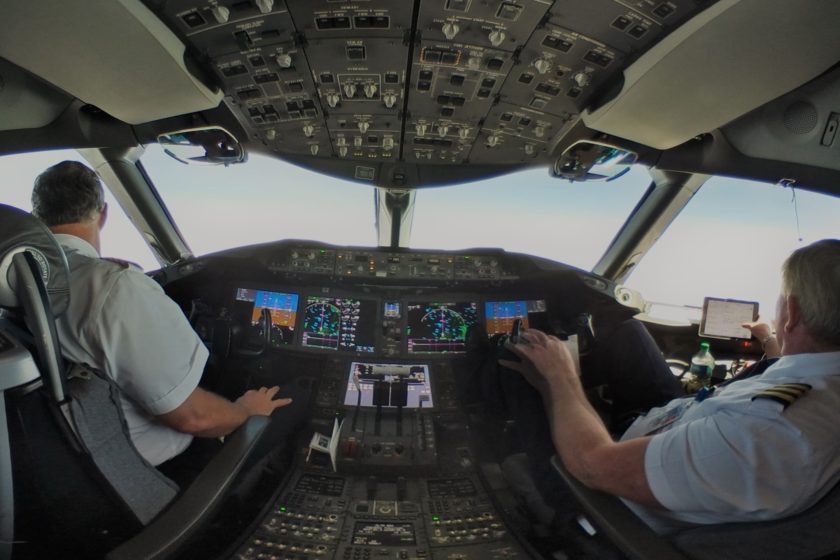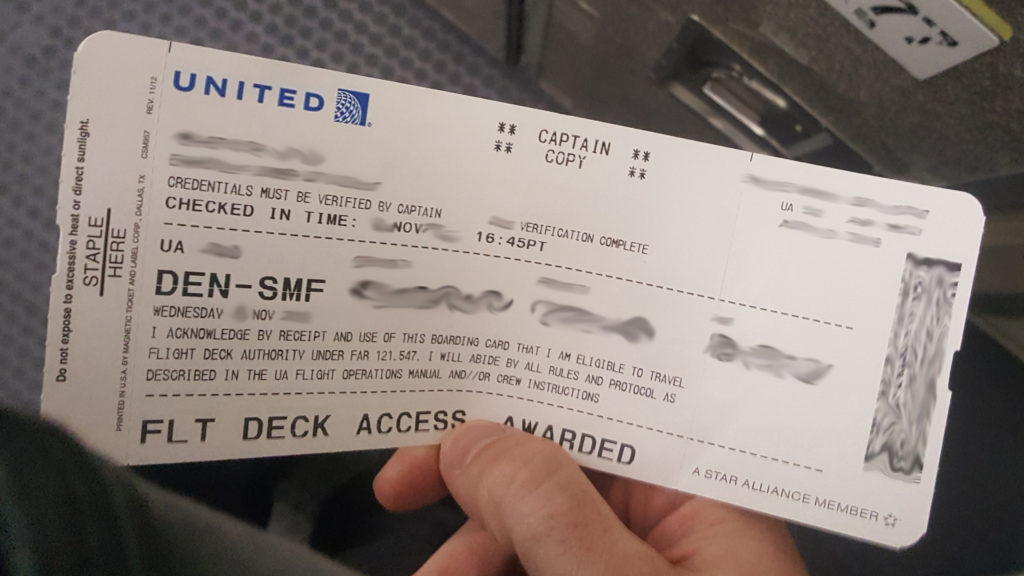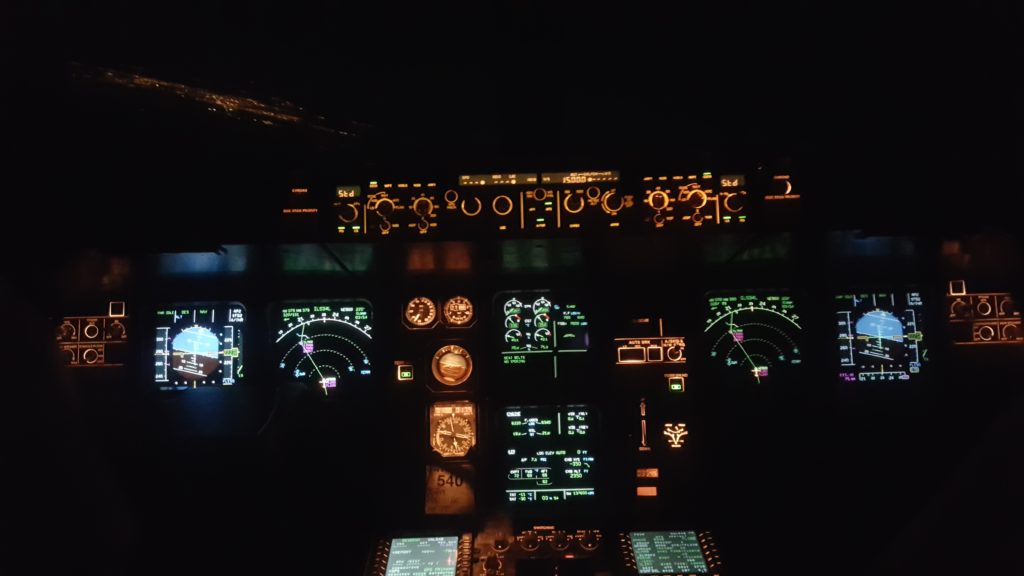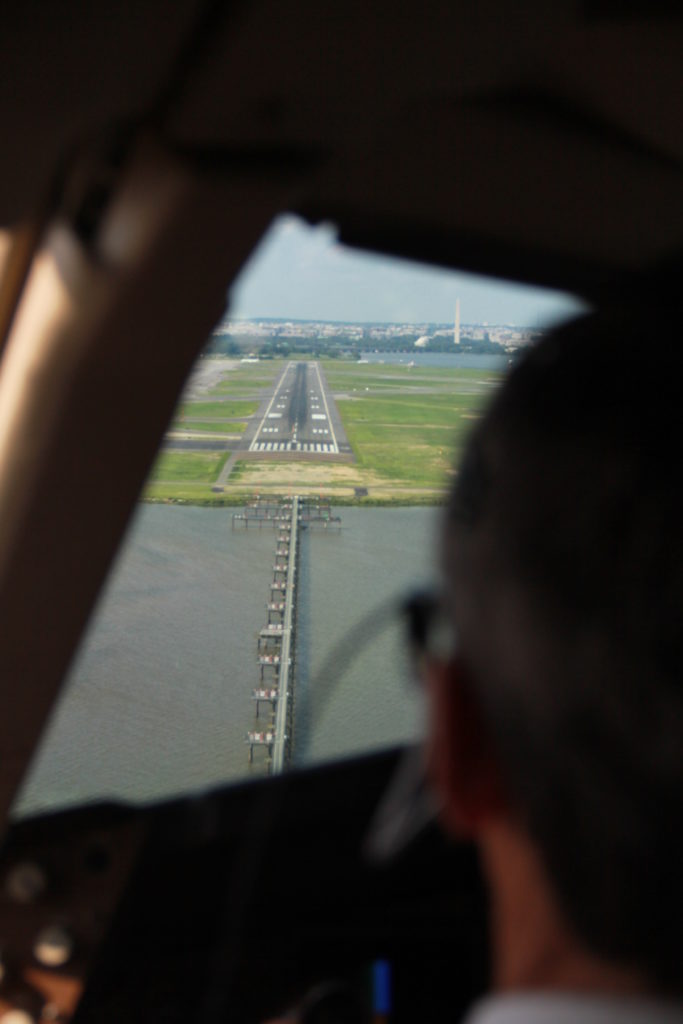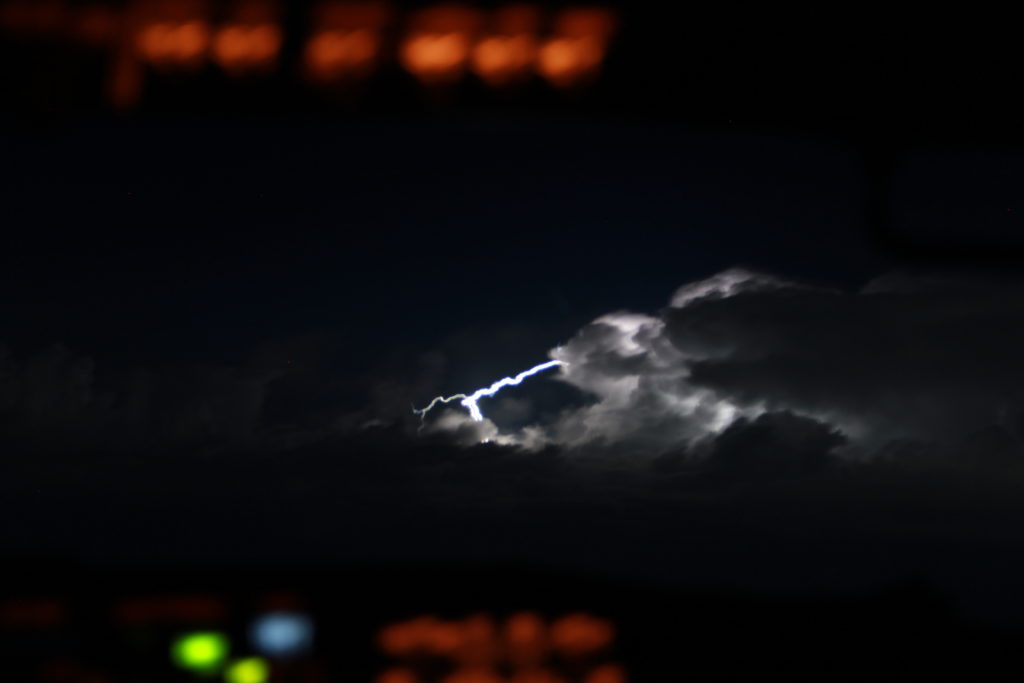Imagine boarding a commercial airliner. You’re the first passenger down the jet-bridge. But instead of being greeted at the aircraft door, you step inside to find there’s not a soul on board. No flight attendants preparing coffee, not even a pilot in the flight deck.
….
Ever since I was a child, I’ve been enthralled with aviation. I vaguely remember (or hallucinated it all) having a VHF radio and listening in to Air Traffic from my home near Washington Dulles. I remember getting my hands on the brand new Flight Simulator ’95 when I was in the 8th grade. But through all that, I could have never fathomed that one day I’d have the chance to sit up in a flight deck of a commercial airline as we travelled across the country.
As part of my position in the aviation industry, I have the unique opportunity to fly in the cockpits of commercial aircraft up to twice a year to gain perspective on the job of a pilot. Given that I’m not a flight inspector, pilot, or employed by the airline, I’m about as close as it gets to being a normal passenger sitting in the front.
I had always wanted to know exactly what goes on up front. As a teen I would plug in the headphone jack and turn to channel 9 (Air Traffic Control radio from the flight deck on United, rarely still available) whenever I could. I would freak out when the plane started turning with no instruction to do so, not understanding that we were on pre-assigned routes and such maneuvers were to be expected.
On my twice annual trips I get to relish in seeing all, hearing all. To say it’s a humbling experience would be an understatement. I also call it the best nerve-calmer available to an anxious flyer like myself (though I’d say pre-flight cocktails on international first class is a close-second).
I’ve done several of these trips now, from a Horizon Dash-8 Seattle to Spokane, to a 777 from Denver to San Francisco.
I’ve flown into Sacramento after dark and I’ve watched the Washington monument pass off my right on our departure from Reagan National.
One of the coolest things I’ve seen is cloud-to-cloud lightning in a passing storm. I managed to get a blurry photo of one of the bolts as it lit up the sky.
On my most recent trip, I sacrificed a direct flight and a better departure time from Dulles to San Francisco in order to fly with United Airlines on one of the latest and greatest aircraft: the Boeing 787.
The first time I had seen one of these beasts was at the Stockton Airport when ANA’s first delivery was conducting test flights across the country. I got up close and personal but never got to step foot inside.
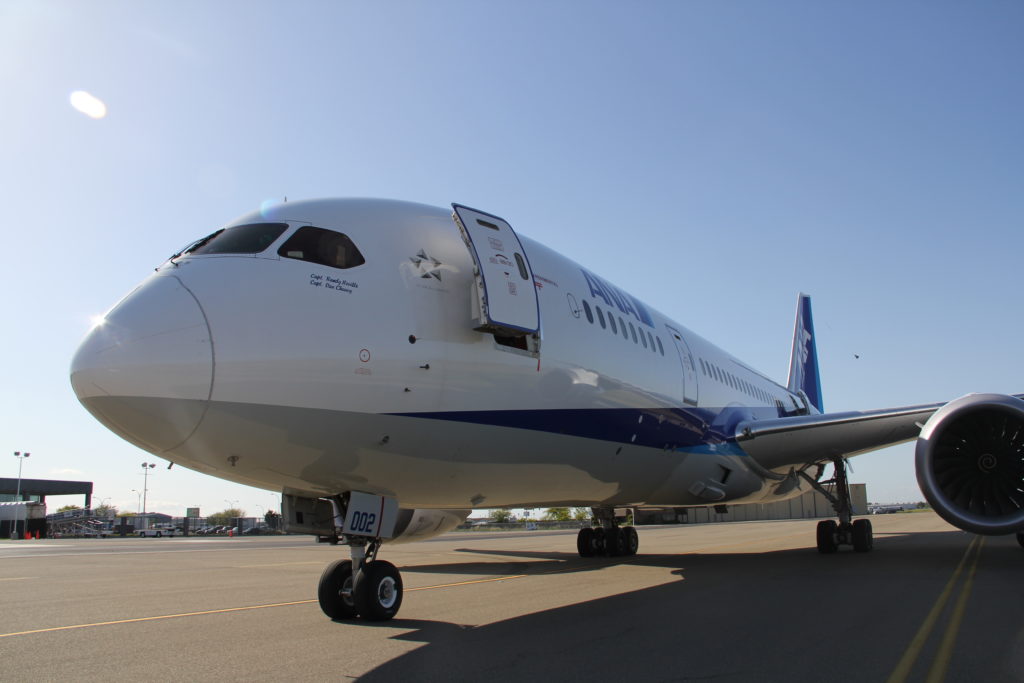
Preparations prior to travelling to the airport involve shaving my goatee (necessary to ensure a solid seal with the oxygen masks in case of an emergency), dressing in business attire (I opt for full suit and tie, though many colleagues of mine go slightly more relaxed), and verifying I have the appropriate paperwork. I took an Airbus A320 from Dulles to Houston, but will not be going into details of that flight.
As for boarding, for the most part I either join crew or get on just before passenger boarding gets underway. I’ve once travelled down the jet-bridge as the incoming flight crew was heading up. They stopped me and asked if I had forgotten something! Nope! When I got on board I was the only soul on the plane. I wanted to run amok, but I refrained. It was several minutes before the outgoing flight crew arrived.
This time around at Houston I had little time between connections, so the pilots were already started on their pre-flight checklists when I boarded.
As an observer and guest of both the pilot’s and the airline’s, I treat the process and the pilots with the same respect passengers gave 40+ years ago.
As boarding commences, my number one goal is to stay out of everyone’s way. On smaller aircraft I find a corner in the galley to compress myself in, and you might find yourself wondering why there’s a suit-and-tie smiling at people as they enter. In the case of the 777 and 787 it’s much easier to hang around just behind the flight deck while boarding commences.
Much back-and-forth occurs between the pilots, flight attendants and ground crew as the flight revs up. Passenger count, baggage weight, and plenty more are shared with the pilots before the door ever closes. Occasionally I’ll squeeze behind the first officers seat and hover over the co-pilot while weather is reviewed, data is passed via ACARS (Aircraft Communications Addressing and Reporting System), the route is verified and input into the system, and systems are checked.
In all cases of joining the flight deck, the pilot verifies credentials and gives the jump seat safety briefing. I’m shown the location of oxygen masks and given evacuation procedures. While most flight decks feature rope to use in the event of a cockpit evacuation, the 787 features an inertia reel. I know where it is, I don’t anticipate needing it.
I’m told that if I see something, say something. No, this is not the homeland security motto, this is a matter of maintaining situational awareness, and the pilots will take any help they can get. They’ve got two extra sets of eyes up front, even if one pair (mine) is inexperienced in the field: we’re gonna fly safe today.
The crew gives us all giant water bottles to keep up front, and asks the captain and FO when they wanted their meals. I’m never entitled to nor do I ever ask for anything more than water, but more often than not I end up with breakfast or another meal during the flights.
While hanging about around the flight deck door, I notice another door open behind me and a couple of stairs: another jump-seater would be utilizing the crew quarters on our trip over. I had never seen crew quarters. I still haven’t, as I neglected to pop my head in.
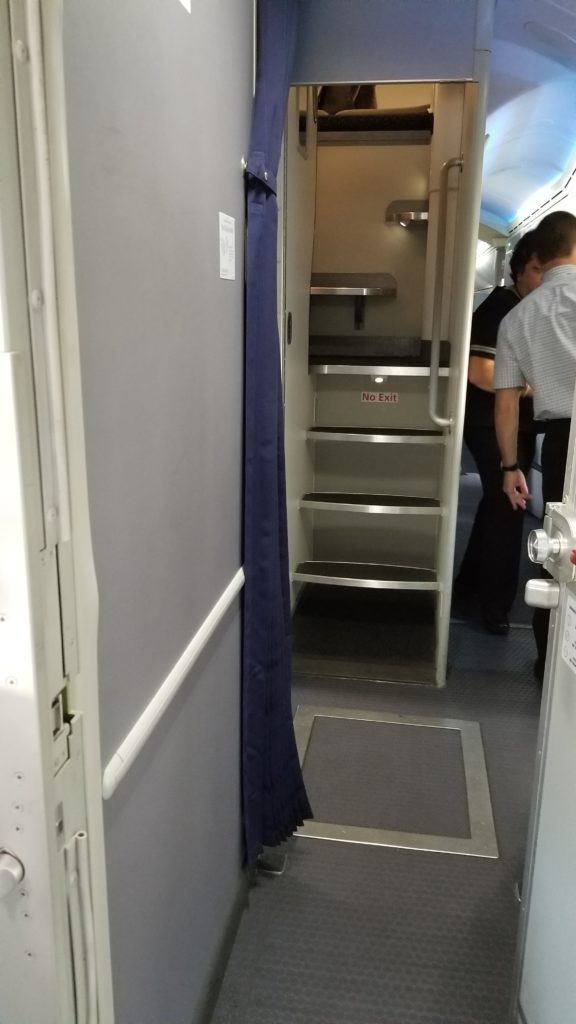
A member of the flight crew passes the final count to the captain- fuel, passengers, weight: they wish us a good flight and close the door.

In our case there is an EDCT to San Francisco. Essentially Air-Traffic Control related delays, EDCT stands for “Expect Departure Clearance Time”. We have a range of when we’ll be leaving, but it’s not definitive.
Fortunately the wait is not too long, and we get our pushback. ATC (Air Traffic Control) assigns our runway and our route over and we follow the taxiways out to Runway 15 Left.
I follow the pilots’ lead and strap in my 5 point harness… why don’t the passengers get these?
The things to know up front are that pretty much from time of pushback until reaching 10,000 feet above sea level, I am required to observe “sterile cockpit” procedures. During the critical phases of flight-taxi, takeoff, and landing- any extraneous conversation is prohibited. As for the captain and FO, the restriction extends to activities as well. If it’s more than taking a sip from their water bottle, you won’t see them doing it.
We line up on the runway as instructed by the tower, and a minute later we get our takeoff clearance.
As we throttle up, anything and everything loose goes flying, and with 8+ of these flights under my belt, for the first time I’ve remembered to secure everything that needs to be secured.
Some of the sole excitement occurs when the tower informs us of general aviation traffic 8 miles west of us, manuevering around 4,000 feet. We are updated about this traffic by the radar facility, and I spot the target on the plane’s radar.
As we get closer, the in-flight computer alerts us to traffic getting closer, but before we get too close, the Captain spots the conflicting aircraft out to our left, on course to pass behind us. “Perfect place to have a Cessna 182,” he notes.
Like on most flights, the cruise portion mainly involves communications transfers between Air Traffic Control facilities. You’d be impressed that amidst light conversation and other duties these pilots rarely miss a call. (Though even a single missed call per plane can quickly add up in the ATC world)
If we encounter any turbulance, the pilots may ask for conditions reports at various altitudes. But just because the ride is smoother 2000 feet higher doesn’t mean we’ll request it, as often times there may be faster headwinds at a different altitude that would cause our flight to slow down. In the case of light bumps along the way, speed is usually prioritized over comfort.
This time around though we stick with our planned cruise altitude the entire trip and have little to no turbulence during the flight.
The only other excitement comes in the form of our restroom break. As you can imagine, accomplishing this is something of a hassel. For that reason I never dare ask for one. On my outbound trip direct to Dulles the pilot mercifully suggests it about a third of the way through the flight and I take advantage. On my IAH-SFO return, it comes a little earlier.
I observe, learn and report throughout the flight. There’s not all that much to see out the window during cruise, as clouds obscure much of what is below. I often look at the onboard radar, attempting to identify navigational fixes and airports. At one point, among a sea of 20+ identifiers in the area, I can name one: ABQ (Albuquerque). My skills improve as we get closer to my home region at SFO.
As we close in on our destination, the first officer points out Yosemite to me. I’m enthralled to see this beautiful park from 35K+ feet in the air. I can see half-dome and Yosemite falls, and snap some photos. They come out like any other photo taken miles away through thick airline glass.

We strap in for our descent, and I watch the clouds rise up and around us.
The pilots run through the landing checklist as we descend through 2500 feet. As soon as we break through the cloud layer we spot the runway. The First Officer Shuts off autopilot and they confirm that the landing checklist has been completed. Our landing on Runway 28R is as smooth as it gets.
We wait a short time between runways 28R and 28L, and a United 747 departs RWY 28L before we get approval to cross.
After we park and shut down the engines, the pilot tells us we’re free to go, and we open the door. Occasionally I’ll have to wait until the after-landing checklist is complete, but most of the time I exit with business/First Class passengers. My first order of business is to find a restroom to change out of my business attire.
As part of the privilege of flying flight deck, I’m required to submit a report on what I learned/what I discussed. These are some of things I reported:
“We talked about ATC communications and frequency changes. Specifically I asked if they required a double check similar to the kind they do during altitude assignments for frequency changes. They said that they do not need that. During the flight there were a couple instances of incorrect frequency assignment.
Regarding Wake Turbulence, the first officer noted there was an offset button available to offset the plane’s course by a mile left or right to avoid any wake turbulence from aircraft ahead. She also mentioned though that controllers were averse to such a thing.
Also in general discussion the pilot noted there seemed to be less constraints on the east coast than west, and that they were subject to a lot more vectoring than having to stay on RNAV assignments.
I asked about any special consideration with hold short instructions. While the pilot stated he had none, the First Officer mentioned how he would often note the instructions via the scratch-pad in ACARS.
I asked about the requirements for a walk-around inspection pre-flight. Per United policy the pilots are required to conduct a walk around prior to flight. They generally are just looking for major structural problems that would make the plane non-airworthy.
The final thing we talked about was general workload in phases of flight. Of course takeoff and landing put the most workload on the crew. During cruise the majority of work involves frequency changes, evaluating turbulence and whether to change altitudes, and preparation for landing.”
The following videos of mine feature an A320, a 737 (With 3D Option), a 777 (Also With 3D Option), and of course the 787 (Presented in 360⁰):

